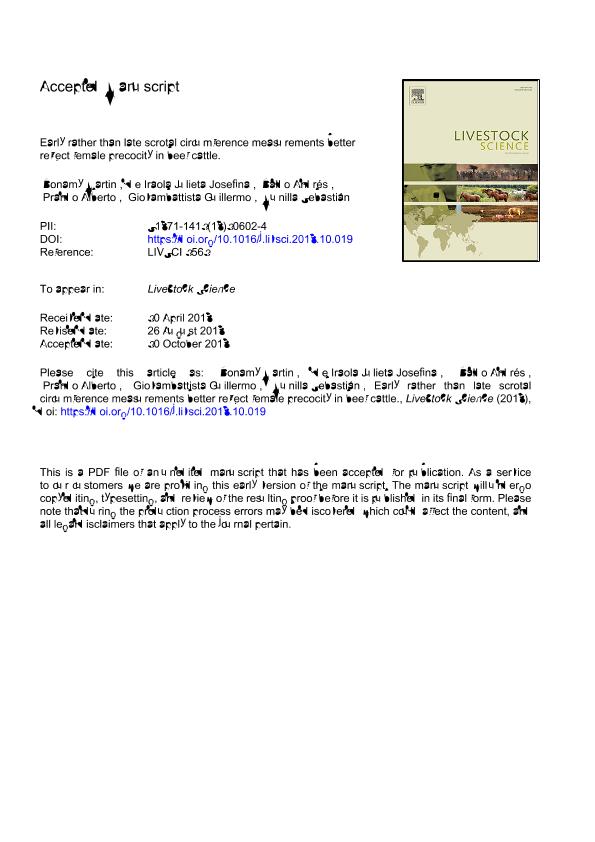Mostrar el registro sencillo del ítem
dc.contributor.author
Bonamy, Martin

dc.contributor.author
de Iraola, Julieta Josefina

dc.contributor.author
Baldo, Andres

dc.contributor.author
Prando, Alberto José

dc.contributor.author
Giovambattista, Guillermo

dc.contributor.author
Munilla Leguizamon, Sebastian

dc.date.available
2019-09-19T15:54:51Z
dc.date.issued
2018-12
dc.identifier.citation
Bonamy, Martin; de Iraola, Julieta Josefina; Baldo, Andres; Prando, Alberto José; Giovambattista, Guillermo; et al.; Early rather than late scrotal circumference measurements better reflect female precocity in beef cattle; Elsevier Science; Livestock Science; 218; 12-2018; 79-84
dc.identifier.issn
1871-1413
dc.identifier.uri
http://hdl.handle.net/11336/83899
dc.description.abstract
In cow-calf operations the moment the heifer achieves her first pregnancy set up her future productivity. Although puberty itself is a yes-or-no condition, time to the event has a quantitative genetic basis and thus is suitable for genetic selection. However, the trait is difficult to measure directly and proxies such as age at first calving (AFC), or scrotal circumference (SC), are typically used. In genetic evaluations, the age at which SC is measured usually corresponds to last part of pubertal development phase. But given that initiation of puberty in both sexes is controlled by the same neuroendocrine mechanisms, we argue that an earlier measurement, taken instead at the start of the pubertal development phase, is probably a better indicator of female precocity. To support the hypothesis, we fitted a multiple-trait animal model on AFC records and SC measurements taken at 300, 400, and 630 days of age and estimated heritabilities and genetic correlations by REML. Importantly, usually AFC data is afflicted by the problem that when breeding season starts most heifers are already cycling (which is, of course, the desired condition) and thus the record poorly reflects precocity. To avoid the problem, in this study we used records collected from an Angus herd in which heifers receive an early natural first service at 375 days of age. Genetic correlation between AFC and SC300 was twice as large as the one corresponding to SC400 (–0.478 ± 0.13 vs –0.244 ± 0.11) and three times larger than to SC630 (–0.478 ± 0.13 vs –0.152 ± 0.12), a result that supports our hypothesis. Heritabilities for SC300, SC400 and SC630 were 0.429 ± 0.07, 0.704 ± 0.07 and 0.576 ± 0.08, respectively, and 0.371 ± 0.05 for AFC. Our results have an important implication in the age at which SC, as an indirect trait for improving precocity, is typically measured in beef cattle breeding programs. Indeed, they indicate that measurements should be taken earlier.
dc.format
application/pdf
dc.language.iso
eng
dc.publisher
Elsevier Science

dc.rights
info:eu-repo/semantics/openAccess
dc.rights.uri
https://creativecommons.org/licenses/by-nc-nd/2.5/ar/
dc.subject
Age at First Calving
dc.subject
Angus
dc.subject
Heifer
dc.subject
Puberty
dc.subject
Scrotal Circumference
dc.subject.classification
Otras Producción Animal y Lechería

dc.subject.classification
Producción Animal y Lechería

dc.subject.classification
CIENCIAS AGRÍCOLAS

dc.title
Early rather than late scrotal circumference measurements better reflect female precocity in beef cattle
dc.type
info:eu-repo/semantics/article
dc.type
info:ar-repo/semantics/artículo
dc.type
info:eu-repo/semantics/publishedVersion
dc.date.updated
2019-09-04T20:03:27Z
dc.journal.volume
218
dc.journal.pagination
79-84
dc.journal.pais
Países Bajos

dc.journal.ciudad
Amsterdam
dc.description.fil
Fil: Bonamy, Martin. Consejo Nacional de Investigaciones Científicas y Técnicas. Centro Científico Tecnológico CONICET- La Plata. Instituto de Genética Veterinaria "Ing. Fernando Noel Dulout". Universidad Nacional de La Plata. Facultad de Ciencias Veterinarias. Instituto de Genética Veterinaria; Argentina
dc.description.fil
Fil: de Iraola, Julieta Josefina. Consejo Nacional de Investigaciones Científicas y Técnicas. Centro Científico Tecnológico CONICET- La Plata. Instituto de Genética Veterinaria "Ing. Fernando Noel Dulout". Universidad Nacional de La Plata. Facultad de Ciencias Veterinarias. Instituto de Genética Veterinaria; Argentina
dc.description.fil
Fil: Baldo, Andres. Universidad Nacional de La Plata. Facultad de Ciencias Veterinarias; Argentina
dc.description.fil
Fil: Prando, Alberto José. Universidad Nacional de La Plata. Facultad de Ciencias Veterinarias; Argentina
dc.description.fil
Fil: Giovambattista, Guillermo. Consejo Nacional de Investigaciones Científicas y Técnicas. Centro Científico Tecnológico CONICET- La Plata. Instituto de Genética Veterinaria "Ing. Fernando Noel Dulout". Universidad Nacional de La Plata. Facultad de Ciencias Veterinarias. Instituto de Genética Veterinaria; Argentina
dc.description.fil
Fil: Munilla Leguizamon, Sebastian. Consejo Nacional de Investigaciones Científicas y Técnicas. Centro Científico Tecnológico CONICET- La Plata. Instituto de Genética Veterinaria "Ing. Fernando Noel Dulout". Universidad Nacional de La Plata. Facultad de Ciencias Veterinarias. Instituto de Genética Veterinaria; Argentina. Universidad de Buenos Aires. Facultad de Agronomía. Departamento de Producción Animal; Argentina
dc.journal.title
Livestock Science

dc.relation.alternativeid
info:eu-repo/semantics/altIdentifier/url/https://www.sciencedirect.com/science/article/pii/S1871141318306024
dc.relation.alternativeid
info:eu-repo/semantics/altIdentifier/doi/https://doi.org/10.1016/j.livsci.2018.10.019
Archivos asociados
